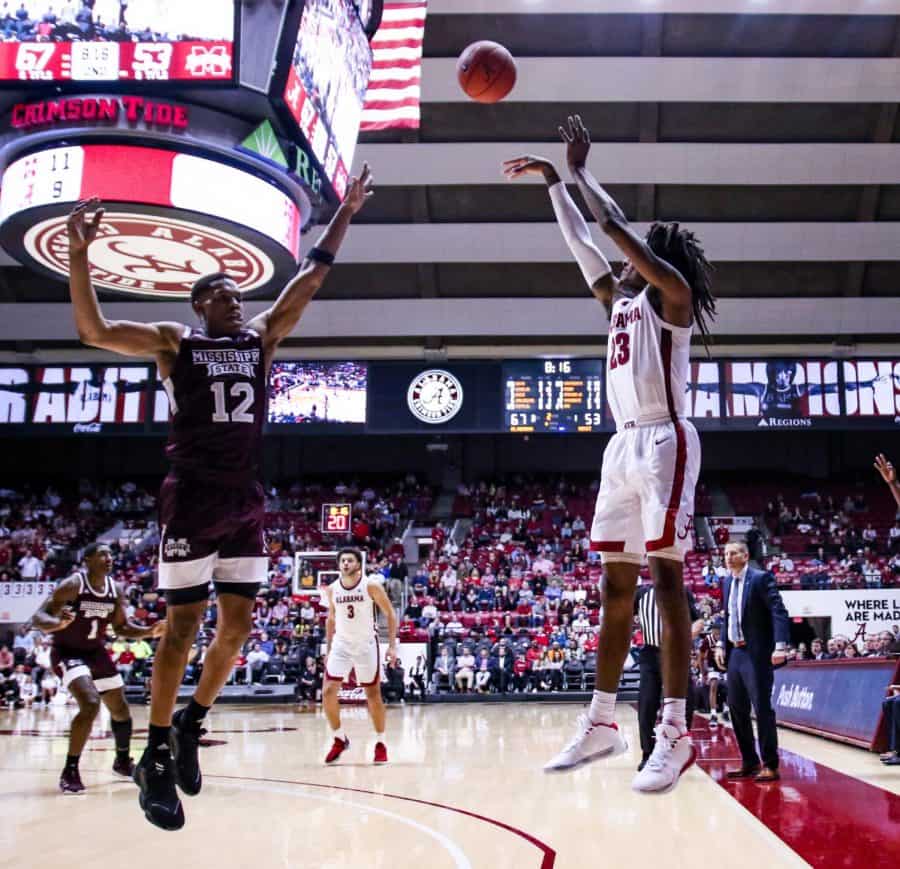Men’s basketball clicking under Oats’ offensive system
January 15, 2020
Before arriving at Alabama, Nate Oats was accustomed to not losing many games. His winning percentage as the men’s basketball coach at Buffalo was 69.1%, as his Bulls averaged 24 wins per season, including two single digit-loss seasons in his final two seasons.
But through his first six games as Alabama’s head coach, the Crimson Tide had already lost four games, the same number that Oats’ 2018-19 Buffalo team lost in 36 games.
During this stretch, Oats emphasized that Alabama’s difficult non-conference schedule, which ranks 39th in the country and first in the SEC, allowed the team to recognize its weaknesses quickly. He also said he wanted his team to be playing its best basketball not in November and December, but rather in February and March leading up to the SEC and NCAA tournaments.
Ever since Alabama’s loss to Iowa State in the Battle 4 Atlantis tournament in late November, Alabama has found its rhythm by winning six of its past nine, which included a stretch of scoring 90 points in five straight games for the first time in program history.
All three losses during that stretch were on the road: Alabama blew a 9-point lead in the second half against Penn State, squandered a 21-point first-half lead and a 6-point lead in the final 43 seconds against Florida and was within three points at Kentucky with under two minutes remaining.
These three losses, in addition to a narrow 1-point loss to Penn to open the season, have resulted in Alabama being ranked 339th out of 353 teams in KenPom’s “Luck rating,” which calculates the difference between a team’s expected winning percentage and actual winning percentage.
“There are a bunch of tweaks [we have made],” Oats said. “We’re trying to get better through the course of the year. Our transition defense has gotten better. Our rebounding has gotten better. Even though the numbers aren’t showing it, our defense has gotten better. And obviously we aren’t turning the ball over.”
To begin the season, turnovers plagued the Crimson Tide offense, which averaged just under 19 per game in the first six games. The team was also allowing opponents to easily turn the takeaways into points on the other end, with Rhode Island turning 21 turnovers into 33 points.
But since then, Alabama has slowed down its offense, with more than 80 possessions in just one of its last nine games. The Crimson Tide has improved to 13 turnovers per game over that stretch.
“I told them if we have to slow down to take care of the ball, we need to,” Oats said. “You can’t keep turning the ball over 22 times, but I knew it would come. It happens. Our first team at Buffalo wasn’t used to playing this fast. Eventually, they get used to playing at that speed and taking care of the ball at that speed.”
Another vital part of Oats’ system is shooting 3-pointers at a high volume — Alabama’s 29 attempts and 10.7 makes per game both rank in the top 10 in the country.
“I feel like everything is coming together,” junior guard John Petty Jr. said. “I feel like the guys are learning the plays, getting them down like the back of their hand. More of our freshmen are feeling more confident. You can tell by the way we are playing that everyone is starting to fill out Coach’s system and his plan, and I feel like everyone is buying in.”
Petty has been leading the Crimson Tide’s 3-point attack since shooting 20% in the first three games of the season. Since then, Petty has shot 57% from beyond the arc.
“My confidence level is probably at an all-time high right now,” Petty said. “I feel like I’m playing more freely like I did in high school. It’s just the repetition we get up in here and the confidence that Coach puts in us by letting us know if you work on it, it’s all gonna come together.”
Prior to the Kentucky game, 39% of Alabama’s points had come from beyond the arc, but during that game, the Crimson Tide started 3 of 13 from 3-point range and finished 4 of 21 (19.0%).
“I felt like we got away from what we do,” Oats said. “Whether it was guys trying to do too much on their own or it was missing good looks early, so we go away from shooting three. No, that’s not how we play. I told them I don’t care if we go 0 for 10 from three. Every time you get an open shot, you’re taking it… We are used to making 11 threes a game. We can’t just shoot 21 and assume we make 11. If we are gonna make 11 threes, we need to put up 30, so we should have shot at least 10 more threes in my opinion.”
Tonight Alabama will finish its toughest four-game stretch of the season by facing undefeated, No. 4-ranked Auburn in Coleman Coliseum, its third Quadrant 1 game in four games. The NCAA Evaluation Tool, or NET, defines Q1 games as home games against top-30 opponents, neutral-site games against top-50 opponents and road games against top-75 opponents.
It will not be the first time an undefeated SEC team has come to Coleman Coliseum in recent years, as guard Riley Norris led Alabama to a 73-50 win over 15-0 South Carolina in 2016.
“Our guys know what’s at stake,” Oats said. “Most of them have been involved in this rivalry a lot longer than I have, so they are pretty focused and involved. Every game for us in the SEC is big now, but obviously the Auburn game probably holds a little bit more weight.”








